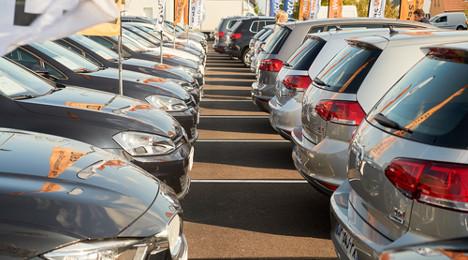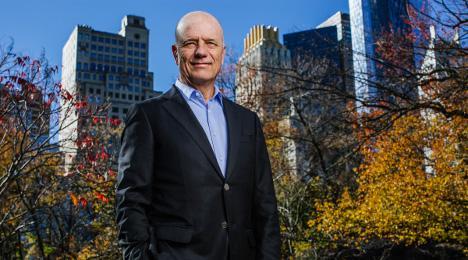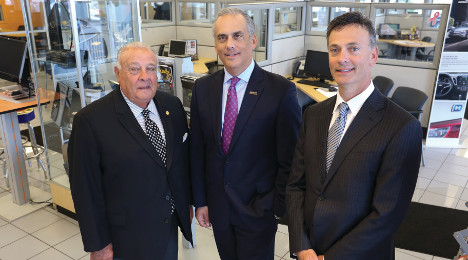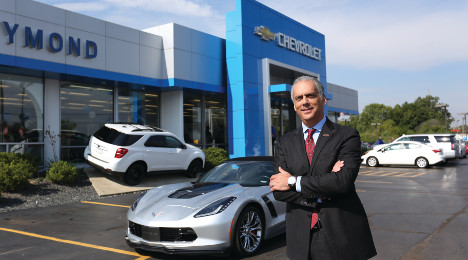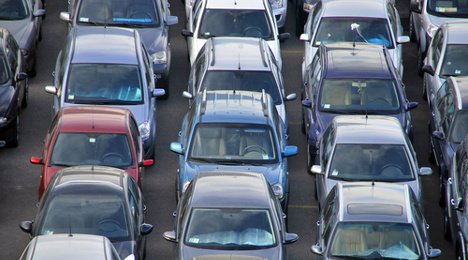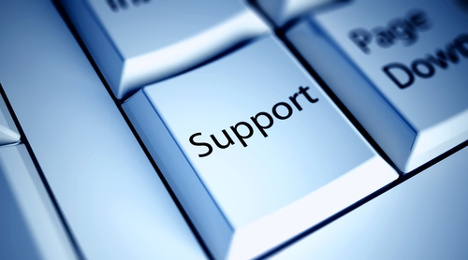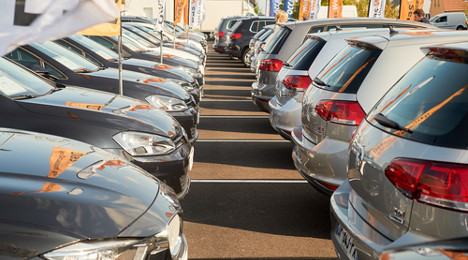A little more than a month after announcing plans to acquire a standalone used-car store chain in the Northeastern U.S., Penske Automotive Group has done the same in the U.K.
Penske announced Friday that it has signed an agreement to buy CarShop, a chain of five standalone used-car retail stores in the U.K.
This follows a move announced Dec. 1, when Penske said it had signed a deal to buy CarSense, a standalone used-car retailer whose no-haggle model focuses on late-model units. CarSense has five stores throughout the Pittsburgh and Philadelphia metro areas, including southern New Jersey.
As for Friday's deal in the U.K, CarShop has locations in Cardiff, Swindon, Northampton, Norwich and Doncaster. The company, which launched in 1999, also has a 15-acre vehicle preparation center in Leighton Buzzard that can recondition 45,000 cars a year.
Penske Automotive Group chairman Roger Penske said in a news release: “The acquisition of CarShop furthers our diversification strategy within the transportation services industry, and is complementary to our existing core auto retail business.
“Similar to the U.S. market, used-vehicle sales in the U.K. are nearly three times the size of new vehicle sales on an annual basis. The CarShop acquisition, combined with the pending acquisition of CarSense in the United States, strengthens our market position in our two largest markets (United States and United Kingdom) while providing scalable future growth opportunities,” Penske added.
The deal must meet certain conditions and is expected to close by end of quarter. The dealer group estimates CarShop will generate annualized revenues of approximately $340 million, with accretion at an estimated $0.07 to $0.09 per share annually.
On Monday, TrueCar shared a handful or so of updates to its Dealer Pledge initiative for 2017 and said these enhancements will be the “centerpiece” of its efforts at the NADA Convention & Expo later this month.
The company launched its Dealer Pledge in March to address concerns from TrueCar Certified Dealers. Among the six updates for 2017 is version 2.0 of its Sales Analyzer analytics tool.
The upgraded tool will include an interactive zip code map and feature new intelligent market segmentation by Competition Zone.
Another is specifically related to pre-owned.
To help used-car operations at dealerships, TrueCar is airing advertisements around pre-owned. Used cars represent 30-plus percent of dealer sales from their leads, the company said.
Other changes include the following:
- To give dealers higher quality leads that convert quickly, adding Car and Driver and Sam’s Club as partners and text/email verification.
- Dealer Summits for training and best practices
- Dealers can post their marketing assets and YouTube videos on TrueCar.
- Coming this year: dealers will be able to price at the VIN-level.
“As a sign of our commitment to dealers, we’re keeping the Pledge alive in 2017. Throughout the year, we will continue to make changes to our business and update our Pledge based on ongoing Dealer feedback,” TrueCar president and chief executive officer Chip Perry said in a news release.
“We want our dealers to view the Pledge as a living roadmap for addressing dealer concerns, and we welcome all of our dealers’ comments and ideas,” Perry continued.
TrueCar is also continuing its $50K Challenge at NADA to help veterans. The company is donating $150 for every visitor to its booth, up to $50,000.
AutoNation announced on Wednesday that it's begining the year by hosting a coast to coast all-day hiring event on Tuesday in 15 cities.
There are thousands of sales and service positions available at all stores and service centers, according to AutoNation.
Store management will be present at each city’s hiring event and offers will be extended to candidates on the spot.
All new hires are scheduled to start on Jan. 23. Additionally, new sales associates will be enrolled in the company's "Sales Ignition" course.
Sales Ignition, a paid training experience recently launched by AutoNation, provides new sales associates a platform to develop their selling skills.
Potential candidates are asked to register at www.AutoNationHIREMENOW.com.
The challenges facing franchised dealers these days are as big as they are diverse.
Regulatory pressure from Washington, D.C. A vehicle recall process that can be frustratingly sluggish.
Technological changes that impact the retail model, vehicle ownership and the vehicles themselves.
But if there’s one thing dealers have in their arsenal it’s this: resiliency.
That was clear when talking with the man who is set to lead the nation’s franchised auto dealer body in 2017: Mark Scarpelli, who is president of Raymond Chevrolet and Raymond Kia in Antioch, Ill., and co-owner of Ray Chevrolet and Ray Chrysler-Jeep-Dodge-Ram in Fox Lake, Ill.
Scarpelli, who is the 2017 chairman of the National Automobile Dealers Association, shared four top priorities for his tenure leading NADA and the 16,500-plus new-car franchised dealers.
He said in a December interivew with Auto Remarketing that he will emphasize how the dealer franchise system benefits the consumer, and work to keep vehicles affordable through advocacy of dealer issues in Washington, D.C.
Scarpelli is prioritizing working with automakers, while also bringing in the next generation of dealers into NADA involvement.
A lot of that work involves keeping the consumer as a top priority.
“At the end of the day, they pay our wages. We want to make sure that our services are something that they want and desire, and that our automobiles — whether they be new, financed or leased — are affordable to them,” Scarpelli said in the phone interview. “We want to make sure that system is intact for them going forward.”
Regulatory challenges
The job of being an auto dealer isn’t necessarily an easy one. There are hurdles to clear, left and right. One of the most talked-about is the regulatory environment the industry faces.
“Some of the well-intended regulations and laws and initiatives from D.C. are just that. But there are some unintended consequences that we live and we breathe every day, and we deal with,” Scarpelli said.
Regulations around auto financing and initiatives from the Consumer Financial Protection Bureau regarding indirect financing are examples of the hurdles, he said.
Dealers also have to maneuver through recalls and changing fuel-economy regulations.
“At the end of the day, I’ll just gravitate back to what I said earlier, it’s all about affordability for American families and we want to make sure that affordability for cars is within reach of Americans,” he said.
“Another opportunity for us, as auto dealers, is our fleet — meaning the cars and trucks on the road owned by American consumers — is one of the oldest fleets in a very, very long time. That being said, the turnover, if you will, of older cars to newer cars and trucks … there’s an opportunity there. And there’s new people coming into the market, meaning new drivers and people that want to upgrade their older automobile.”
The recall process
Another thorn in the side of car dealers and the consumers they serve has been the flood of recalls and the lengthiness it sometimes takes for a fix.
“At the end of the day, car dealers are there to sell, service automobiles and to please the public,” Scarpelli said. “And in our case, as an automobile dealer, trust me, we will service and fix recalled vehicles 100 percent of the time, every day until the end of time. One of the roadblocks that currently exists is the parts availability for some recalls.
“Many times, recalls are announced to consumers the same time that we, the automobile dealer, find out. So, we end up getting up a black eye, if you will, that we don’t have the parts or we’re not up to speed for the recall — meaning that if we had availability of parts, we could fix them right away,” he said.
“And we have no interest in not fixing them right away. Consumer safety and getting that car back to where it was originally designed to be is our primary interest, period,” Scarpelli said.
“The solution, really, is to have safety regulators recognize that not all recalls present an imminent threat to safety, and for some of our dealers to acknowledge that recalls need to be fixed right away and should be fixed before the sale of the automobile. So that’s how I think we can get there.”
Response to online shifts
Think about the way a consumer might shop for a car today. Instead of driving to six to eight dealerships, he said, the shopper is able to compare stores online.
But while they can narrow down their choices through a smartphone, tablet or laptop, “there’s still a large part of the American buying public that still loves to go and touch and drive and feel that new automobile,” Scarpelli said.
“Whether it starts online or looking on dealers’ lots, at the end of the day, it’s still an emotional purchase,” he said. “Meaning that, you’re excited about the new color or that it’s got eight cylinders versus six cylinders or it’s got the rear-seat, child-seat warning — which is a cool option, by the way — or the backup camera. Those things can’t be demonstrated online or in a list of options. People still need to come into an automobile dealership and touch and feel that stuff, which is the benefit of our large dealer network that we have in America.”
But given how vastly the car business has changed — be it autonomous cars, ride-sharing, digital car-buying or evolving ownership models — how can dealers work with the changing pieces?
“Automobile dealers are very resilient,” he said. “I’ve been in the business since I was 22; I’m 52, now. The evolution and the change that has happened in our business is mind-blowing. What I was doing five years ago until today is not the same activity. We don’t have that crystal ball but what we are good at is being resilient and willing to change. It looks real exciting to me as an automobile dealer, and I would say that for most automobile dealers.”
He pointed to the “The Dealership of Tomorrow: 2025” study that was commissioned by NADA and conducted by consultant Glenn Mercer.
“In our world, we don’t feel as though the dealer franchise network will change significantly, meaning the actual physical plant of the dealership. It’s still a place and it’s the best network to buy your car, to fix your car, to do warranty repairs. It’s still the No. 1 source in America,” Scarpelli said.
“And when you think about it, there’s over 16,500 retail outlets where a consumer, if they buy their car in Chicago, Illinois, and they’re driving through Topeka, Kansas, and they have an issue, they can probably get that car serviced through the wide network that sprawls America. So we feel that is never going to change,” he said.
“There are some underlying things that may change, such as buying habits, consumer preferences, regulatory issues that come up. But, you know what, we don’t feel that the industry is going to change that much,” he said.
And if change does come, there are some fundamentals Scarpelli sees as evergreen.
“Cars are still going to still going to need to be purchased. They’re still going to needed to be fixed,” he said. “The network that is on the ground right now is that 16,500 dealer-strong network to sell and to service that automobile. It’s a pretty great network that we’ve put together over the years.”
Year-to-date certified pre-owned sales stood at 2.41 million units at the end of November, according to Autodata Corp., and this was up 3.6 percent and all but certain to break the 2015 sum of 2.55 million units sold.
That would extend the streak of best-ever years for CPO sales to six.
So what is driving this CPO momentum?
“From the CPO perspective, it really — being a car dealer for many years — gives the consumer the peace-of-mind and legitimizes the fact that that car has been, if it were out of spec or something needed to be addressed, it’s put back within factory specs for that year, that model, with that range of mileage on it,” said Mark Scarpelli, the 2017 chairman of the National Automobile Dealers Association.
Scarpelli serves as president of Raymond Chevrolet and Raymond Kia in Antioch, Ill. He is also the co-owner of Ray Chevrolet and Ray Chrysler-Jeep-Dodge-Ram in Fox Lake, Ill.
He talked with Auto Remarketing in December about, among other things, two of the top trends in the used-car retail space: CPO sales and the emergence of standalone used-car stores.
Commenting further on CPO, he said, “You’re looking at it from the manufacturer perspective and it gives people great peace-of-mind. And in many cases, it gives them additional warranty benefits and it’s a really thing to put people’s minds at ease, if you will.”
Scarpelli added: “And many of these cars that become CPO cars … have come out of short-term lease programs, factory program type cars. And that supply of cars continues as the market turns.
“It’s a great place for a consumer to get an awesome deal with an extension of warranty and peace-of-mind, because it’s a CPO car. Sometimes those cars come with finance programs and low interest rates,” he said. “It’s a great thing for a consumer.”
Perhaps another smart move by franchised dealers in the pre-owned space has been the launch of standalone used-car stores.
Penske Automotive Group announced in December that it had signed a deal to buy CarSense, a Northeast-based standalone used-car retailer whose no-haggle model focuses on late-model units.
Sonic Automotive and Asbury Automotive Group each have used-car standalones in EchoPark Automotive and Q auto, respectively. In October, AutoNation revealed plans to begin rolling out its own.
“It’s all about the fleet that’s out there and the cars that are coming (back into the market), whether trade-ins or lease programs,” Scarpelli said of the benefits to this model.
“There’s a supply of them obviously. And in our case, it’s brand-building, whether you’re an independent dealer or a large dealer group,” he said. “It builds loyalty and brand-building to some of those dealer groups that you had mentioned and it’s also an opportunity to hone and drive home certified pre-owned sales. It’s just another avenue to sell that automobile to the buying public.”
OVE and DealShield are offering an online-only promotion through March 31 that gives dealer clients who participate exclusive access to inventory not seen at auction.
“This promotion is ideal for first-time and repeat users of our digital services,” said Derek Hansen, vice president Digital and Inventory Services at Manheim. “Everyone reaps the rewards that come from access to fresh stock, confidence in vehicles backed by condition reports and DealShield’s purchase protection, as well as the ability to stay at their dealership and focus on customers.”
The online program incentivizes dealers to both buy and sell vehicles.
Buyers receive a free DealShield 21 Day Purchase Advantage Guarantee and condition report information.
Along with increased buyer assurance, sellers get a discounted condition report for $35 and reduced transportation expense.
“We are dedicated to helping dealers fill their lots with the right inventory at the right time,” said. “Clients can meet consumer demand for remaining 2016 deals by taking advantage of this promotion and quickly grabbing desirable inventory on OVE.”
Clients can visit http://go.ove.com/ovedealshield to learn more about the program or sign up.
According to VinSolutions' CRM Usage Report, a study co-released by DealerKnows on Tuesday, the average dealer struggles to use their customer relationship management effectively in several key areas.
The recent survey on the automotive industry's overall CRM usage and its impact on dealership performance showed that CRM usage is closely tied to overall dealership success.
DealerKnows surveyed what it called “best-in-class dealers,” a group of stores that recently evaluated its CRM usage and implemented a plan to improve performance, along with a representative sample of dealers nationwide and compared the results.
The analysis found that average dealers substantially trail behind the best-in-class dealers.
Only 44 percent of average dealers received regular automated reports from their CRM, while 83 percent of best-in-class dealers did, according to the study.
Additionally, the study shows the average dealer set four fewer appointments per day, and they report an 11 percent reply rate for emails sent through the CRM, compared to 18 percent for best-in-class dealers.
"At VinSolutions, we've always believed that the CRM is the most important piece of technology for the modern dealership," said Mark Vickery, senior director of performance management. "This study proves that using the CRM well is essential for dealers' success. Although many dealers still have some work to do to get the most value out of their system, we hope this research will be the inspiration they need to start using their CRM more effectively."
CRM usage was judged in three categories: utilization, reporting and lead process.
The full study can be downloaded at www.vinsolutions.com/whitepaper.
On Monday, Helion Automotive Technologies announced a list of five technology priorities for auto dealerships looking to improve operational efficiencies in 2017.
The provider of information technology solutions for auto dealers said appropriating budgets to address the areas of internet bandwidth, wireless, incoming call flow, security and software licensing will help support the upcoming year’s new business and technology initiatives.
"Dealers often view IT as a cost of doing business, rather than as an investment that can help them become more competitive," said Erik Nachbahr, president of Helion. "In this industry, time is money and an outdated IT infrastructure can result in downtime, lost revenue, reduced customer retention and loss of employee buy-in."
Helion's top IT priorities for dealers in 2017:
1. Internet Bandwidth
Fiber optics is the future of Internet connectivity, says Helion. Cloud-based, third-party and OEM applications require greater data throughput than a T1 can handle.
A fiber optics connection carries data at rates ranging from 100 Mbps to 1,000 Mbps (1 Gbps), while a T1 connection carries data at a rate of 1.544 Mbps.
2. Wireless
More wireless is needed for dealerships heightening their use of OEMs and third-party location-based technologies and programs, according to Helion.
The company said the average dealership with six to 10 high-speed wireless access nodes needs to increase their wireless capacity by three to five times, to have a total of at least 25 wireless access nodes per location.
3. Incoming Call Flow
According to Helion, up to 30 percent of incoming phone leads don’t connect with an employee who can assist them.
"Dealers are losing a crazy amount of leads due to something they probably don't think much about," said Nachbahr. He recommends creating a new call flow designed to support dealer processes and to follow it each day with no changes.
4. Security and Regulatory Compliance
Nachbahr's highly suggests that dealers get cyber liability insurance and have security policies established to best evade harsh financial consequences associated with security breaches.
Seventy-five percent of businesses with fewer than 500 employees reported a security breach last year, according to a July report titled IT Security at Small to Mid-Size Businesses (SMBs): 2016 Benchmark Survey. The study is a topic of an August Auto Remarketing article about how dealerships can minimize the risk of costly security breaches.
5. Software Licensing
Nachbahr says dealers need to be sure that their employees are not using unlicensed copies of software.
In the last two years, approximately 45 percent of auto dealerships have been audited by Microsoft, according to Helion.
"One dealership I know of got caught using unlicensed copies of Microsoft Office on over 300 computers, and had to pay a fine of $1.5 million," said Nachbahr. "This is something that dealers cannot afford to mess around with."
Nachbahr suggests dealerships try Microsoft’s cloud-based subscription program, Office 365 Business, if Office 2016 is too costly.
You can count the decision by Roger Penske and his team at Penske Automotive Group to acquire standalone used-car retailer CarSense as a wise one, says Autotrader senior analyst Michelle Krebs.
“It’s a really smart move, of course,” Krebs said during a phone interview Friday. “Roger doesn’t make any dumb moves.”
Penske Automotive announced Thursday that it had signed a deal to buy the Northeast-based standalone used-car retailer, whose no-haggle model focuses on late-model units.
The dealer group said the model — which currently includes five stores throughout the Pittsburgh and Philadelphia metro area — can be expanded elsewhere in the U.S., and Penske plans to use it to broaden the dealer group's used-car footprint.
It’s a particularly deft maneuver by Penske — which joins other public dealer groups in the standalone used-car store space — given some of the supply and demand factors that Krebs shared.
It’s also not the last time we’re likely to hear of a dealership group making this kind of move.
Sonic Automotive and Asbury Automotive Group each have used-car standalones in EchoPark Automotive and Q auto, respectively, while AutoNation has plans to roll out its own.
So why is launching standalone used-car stores a good idea, and what makes the used-car market so attractive?
For starters, used-car supply is only going to continue growing, particularly as off-lease volumes ramp up in coming years, Krebs said.
Meanwhile, consumer demand for used cars is going to be strong because of the “affordability issue” in the new-car market, she said.
In fact, affordability — or lack thereof — has been one of the biggest disruptors to the new-car market, she said.
Yes, urbanization, the buying habits of millennials and car/ride-sharing all have had some impact, and Krebs and her colleagues are keeping close watch on these trends. But they haven’t had the same kind of impact that affordability issues have.
Given the growth in U.S. population, Krebs said, the new-vehicle market should be stronger than it is.
There were about 210 million adults in the U.S. in 2000, a year where 17.4 million new vehicles were sold, according to Cox Automotive, which cited Automotive News and the U.S. Census
In 2015, there were 248 million U.S. adults and 17.5 million new-car sales.
Put differently, they said, it took 38 million more people to reach essentially the same sales total.
The company’s data set takes it a step further and shows that if new-car sales per capita in 2015 had been even with the level in 2000, there would have been 20.5 million new-car sales last year.
But that, of course, didn’t happen.
The new-car market, Cox Automotive emphasized, has an affordability issue.
According to its data set, 57 percent of non-vehicle owners say they don’t have a car because they can’t afford to buy or lease one.
Krebs points out that median income has not risen and the cost of living has “grown exponentially.”
In fact, nearly three-fourths (72 percent) claim their everyday expenses have increased.
Citing the U.S. Census, Cox Automotive indicates that median income in 2014 ($53,657) was only marginally higher than median income in 1990 ($52,623).
Krebs points out that incomes have gone up 21 percent since 1967, but over the same time span, there has been a 596-percent increase in the cost of goods.
Meanwhile, income has actually dropped 7 percent in the last 15 years, she said, with the cost of goods going up 37 percent.
Granted, Krebs added, the price of cars has not shown the same level of increase, but their growth has outpaced that of incomes.
And all of the above tends to impacts the affordability of a new car and tends to make the used car “more desirable,” Krebs said.
There is a considerable contrast between actual start-to-finish transaction times car buyers experience and what dealers believe is ideal, according to eLEND Solutions' survey of dealers nationwide published on Wednesday.
While 36 percent of dealers surveyed said the ideal amount of time shoppers should spend in their dealership during the buying process is less than an hour and 79 percent said less than two hours, the survey found that more than half of the dealers have a process that takes more than two hours.
An overall account of actual transactions times given to eLEND Solutions from the same group of dealers showed that only 11 percent of them see their buyers out in an hour or less and 42 percent in two hours.
Though most dealers have yet to meet their ideal time on average, transaction times reported by dealers have been improving.
Forty percent of dealers surveyed in 2014 reported an over three-hour process and this year only 25 percent said their process took more than three hours.
“We are pleased to see that transaction times are improving for some dealerships, but this continues to be a pain point for many dealers, costing them significant dollars in resources and lost opportunities,” said Pete MacInnis, chief executive officer of eLEND Solutions.
Seventy-three percent of dealers surveyed point to the completion of the finance and insurance (F&I) portion of the car buying process as the main reason for long transaction times.
“These are symptoms of the ‘silo’d’ sales and F&I process,” MacInnis said. “If information flow were consistent and uninhibited across departments, a connected car buying process would be facilitated, time in F&I would be reduced, and the overall transaction times would accelerate.”
The nearly two-thirds of dealers who claimed their transaction times have improved credit their decision to change the finance process, such as pulling credit reports earlier within the transition time from the sales floor to starting steps related to F&I.
But of dealers who say they pull car buyers credit, most wait till far into the purchasing process to do so.
The following figures are surveyed dealers’ response to this question: “At your dealership, when do you normally first pull a customer’s credit?"
• Before the handoff to F&I: 44 percent
• Before the first pencil: 38 percent
• In the F&I office: 10 percent
• Before the test drive: 8 percent
“We believe that pulling credit sooner is a critical — and simple — step to streamlining the process and achieving better CSI and higher closing ratios,” said MacInnis.

